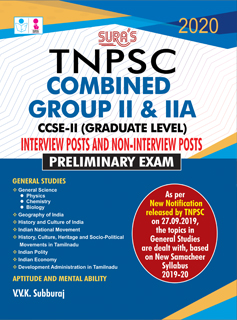1. Who revealed the secrets of the Panchalam Kurichi fort to the British ?
A) Mamulanar
B) Udaiyar Servai
C) Ramalinga Mudaliyar
D) Muthu Karuppan
Explanation : Ans : (C)
On 1 September 1799, an ultimatum was served on Kattabomman to surrender. Kattabomman’s “evasive reply” prompted Bannerman to attack his fort. Bannerman moved his entire army to Panchalamkurichi on 5 September,1799. They cut off all the communications to the fort. Bannerman deputed Ramalinganar to convey a message asking Kattabomman to surrender. Kattabomman refused. Ramalinganar gathered all the secrets of the Fort, and on the basis of his report, Bannerman decided the strategy of the operation. In a clash at Kallarpatti, Sivasubramaniar was taken a prisoner.
2. Which one of the following feature is NOT in the parliamentary system ?
A) Majority Party rule
B) Leadership of Prime Minister
C) Dissolution of Lower House
D) Single executive
Explanation : Ans : (D)
Parliamentary System : The parliamentary government is also known as cabinet
government or responsible government or
Westminster model of government and is prevalent in Britain, Japan, Canada,
India among others. The presidential government, on the other hand, is also
known as non-responsible or non-parliamentary or fixed executive system of
government and is prevalent in USA, Brazil, Russia, Sri Lanka among others.
Ivor Jennings called the parliamentary system as ‘cabinet system’ because the
cabinet is the nucleus of power in a parliamentary system. The parliamentary
government is also known as ‘responsible government’ as the cabinet (the real
executive) is accountable to the Parliament and stays in office so long as it enjoys
the latter’s confidence.
Features of Parliamentary Government :
Nominal and Real Executives
Majority Party Rule
Collective Responsibility
Political Homogeneity
Double Membership
Leadership of the Prime Minister
Dissolution of the Lower House
Secrecy
3. Steel Industry is popularly called as
A) Oldest industry
B) Traditional industry
C) Mother industry
D) Private industry
Explanation : Ans : (C)
Steel Industry is popularly called as “Mother industry” because:
All the other industries – heavy, medium and light, depend on it for their machineries.
It is also helpful in providing employment
It also helps in the development of agriculture.
The Ministry of Steel, Government of India, is responsible for planning and development of iron and steel industry, development of essential inputs such as iron ore, limestone, dolomite, manganese ore, chromites, ferro-alloys, sponge iron etc, and other related functions.
India is also an important producer of pig iron. Post liberalization, with setting up of several units in the private sector, not only imports have drastically reduced but also India has turned out to be a net exporter of pig iron. The private sector has accounted for 94 per cent of total production for sale of pig iron in the country in 2016-2017 (prov).
India was the third largest crude steel producer during this period and recorded a growth of 7.4 percent over 2015.
4. As per 2011 census, India’s lowest sex ratio prevails in which state ?
A) Bihar B) Kerala
C) Haryana D) Arunachal Pradesh
Explanation : Ans : (C)
Sex ratio : Sex is defined as the number of females per thousand males. As per Census 2011, Sex of India is 940.
Kerala is the highest sex ratio state in the country with 1084.
Haryana is the lowest sex ratio in the country with 879.
5. Bonding present between the carbon atoms in graphite is
A) Metallic B) Ionic
C) Covalent D) Vanderwaal’s forces
Explanation : Ans : (D)
Graphite is a good conductor of
electricity unlike other
non-metals since it has no free electrons in it.
In graphite, each carbon atom is bonded to three other carbon atoms in the same plane giving hexagonal layers held together by weak Vander Waal’s forces accounting for softness.






